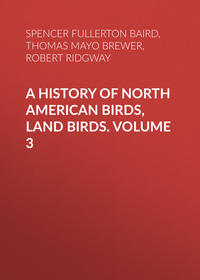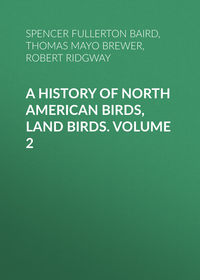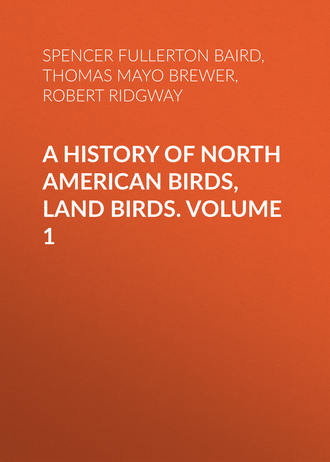 полная версия
полная версияA History of North American Birds, Land Birds. Volume 1
This bird winters in large numbers in Central America, where it is apparently very generally distributed. Mr. Salvin found it very common at Duenas. It was taken at Totontepec, among the mountains of Oaxaca, Mexico, by Mr. Boucard.
Mr. Ridgway found it very common during the summer and autumn months among the willows of the fertile river valleys, and among the rank shrubbery bordering upon the streams of the cañons of the higher interior range of mountains. It was found in similar situations with the Dendroica æstiva, but it was much more numerous. During September it was most abundant among the thickets and copses of the East Humboldt Mountains, and in Ruby Valley, at all altitudes, frequenting the bushes along the streams, from their sources in the snow to the valleys.
Wilson first met with and described this species from specimens obtained in Delaware and New Jersey. He regarded it as an inhabitant of the swamps of the Southern States, and characterized its song as “a sharp, squeaking note, in no wise musical.” It is said by him to leave the Southern States in October.
Audubon states that it is never found in the Southern States in the summer months, but passes rapidly through them on its way to the northern districts, where it breeds, reaching Labrador early in June and returning by the middle of August. He describes it as having all the habits of a true Flycatcher, feeding on small insects, which it catches on the wing, snapping its bill with a sharp clicking sound. It frequents the borders of lakes and streams fringed with low bushes.
Mr. Nuttall observed this species in Oregon, where it arrived early in May. He calls it a “little cheerful songster, the very counterpart of our brilliant and cheerful Yellow-Bird.” Their song he describes as like ’tsh-’tsh-’tsh-tshea. Their call is brief, and not so loud. It appeared familiar and unsuspicious, kept in bushes busily collecting its insect fare, and only varied its employment by an occasional and earnest warble. By the 12th of May some were already feeding their full-fledged young. Yet on the 16th of the same month he found a nest containing four eggs with incubation only just commenced. This nest was in a branch of a small service-bush, laid very adroitly, as to concealment, upon a mass of Usnea. It was built chiefly of hypnum mosses, with a thick lining of dry, wiry, slender grasses. The female, when approached, slipped off the nest, and ran along the ground like a mouse. The eggs were very similar to those of Dendroica æstiva, with spots of a pale olive-brown, confluent at the greater end.
A nest found by Audubon in Labrador was placed on the extremity of a small horizontal branch, among the thick foliage of a dwarf fir, a few feet from the ground and in the very centre of a thicket. It was made of bits of dry mosses and delicate pine twigs, agglutinated together and to the branches and leaves around it, from which it was suspended. It was lined with fine vegetable fibres. The diameter of the nest was three and a half and the depth one and a half inches. He describes the eggs, which were four, as white; spotted with reddish and brown dots, the markings being principally around the larger end, forming a circle, leaving the extremity plain.
In this instance the parents showed much uneasiness at the approach of intruders, moving about among the twigs, snapping their bills, and uttering a plaintive note. In Newfoundland these birds had already begun to migrate on the 20th of August. He met with them in considerable numbers in Northern Maine in October, 1832. Mr. Turnbull mentions it as a rather abundant bird of Eastern Pennsylvania, appearing there early in May, in transitu, and again in October.
Mr. T. M. Trippe has observed this species at Orange, N. J., from the 19th to the 30th of May. It is said to keep low down in the trees, and is fond of haunting thickets and open brush fields. Occasionally he has heard it utter a loud chattering song, which it repeats at short intervals.
A nest of this species from Fort Yukon (Smith. Coll., 13,346), obtained May 20, by Mr. McDougal, contained four eggs. These varied from .60 to .63 of an inch in length, and from .45 to .49 in breadth. They were obovate in shape, their ground-color was a pure white; this was finely sprinkled round the larger end with brownish-red and lilac. No mention is made of the position of the nest, but it is probable this bird builds on the ground.
Myiodioctes pusillus, var. pileolatus, RidgwayMotacilla pileolata, Pallas, Zoög. Rosso Asiat. I, 1831, 497 (Russian America). Myiodioctes pusillus, var. pileolata, Ridgway, Report U. S. Geol. Expl. 40th Par. Myiodioctes pusillus, Auct. (all citations from Pacific coast of North and Middle America).—Lord, Pr. R. Art. Inst. Woolw. IV, 1864, 115 (Br. Col.).—Dall & Bannister (Alaska).—Cooper, Orn. Cal. 1, 1870, 101.
Sp. Char. Similar to var. pusillus, but much richer yellow, scarcely tinged with olive laterally, and deepened into an almost orange shade on the front and chin. Above much brighter and more yellowish olive-green. The black pileum with a brighter steel-blue gloss. Bill much narrower, and deep, light brown above, instead of nearly black. Measures (4,222 ♂, San Francisco, Cal.), wing, 2.15; tail, 2.00.
Hab. Pacific coast region of North America, from Kodiak (Alaska); south through Western Mexico (and Lower California) to Costa Rica.
This is an appreciably different race from that inhabiting the eastern division of the continent; the differences, tested by a large series of specimens, being very constant.
A Costa-Rican specimen before me is almost exactly like specimens from California.
Habits. The remarks, in the preceding article relative to specimens from the Pacific coast belong to this variety.
Myiodioctes canadensis, AudCANADA FLYCATCHERMuscicapa canadensis, Linn. Syst. Nat. I, 1766, 327. (Muscicapa canadensis cinerea, Brisson, II, 406, tab. 39, fig. 4.)—Gmelin.—Wilson, III, pl. xxvi, fig. 2.—Aud. Orn. Biog. II, pl. ciii. Setophaga can. Swains.; Rich.; Gray. Myiodioctes can. Aud. Birds Am. II, pl. ciii.—Brewer, Pr. Bost. Soc. VI, 5 (nest and eggs).—Sclater, P. Z. S. 1854, 111 (Ecuador; winter); 1855, 143 (Bogota); 1858, 451 (Ecuador).—Ib. Catal. 1861, 34, No. 204.—Sclater & Salvin, Ibis, 1859, 11 (Guatemala).—Lawrence, Ann. N. Y. Lyc. VI, 1862.—Baird, Birds N. Am. 1858, 294; Rev. 239.—Samuels, 247. Euthlypis can. Cab. Mus. Hein. 1850, 1851, 18; Jour. Orn. 1860, 326 (Costa Rica). Sylvia pardalina, Bon.; Nutt. Sylvicola pardalina, Bon. Myiodioctes pardalina, Bon. ? Muscicapa bonapartei, Aud. Orn. Biog. I, 1831, 27, pl. v. Setophaga bon. Rich. Wilsonia bon. Bon. Sylvania bon. Nutt. ? Myiodioctes bon. Aud. Syn.—Ib. Birds Am. II, 1841, 17, pl. xvii.—Baird, Birds N. Am. 1858, 295. Setophaga nigricincta, Lafr. Rev. Zoöl. 1843, 292; 1844, 79.
Sp. Char. Upper part bluish-ash; a ring around the eye, with a line running to the nostrils, and the whole under part (except the tail-coverts, which are white), bright yellow. Centres of the feathers in the anterior half of the crown, the cheeks, continuous with a line on the side of the neck to the breast, and a series of spots across the forepart of the breast, black. Tail-feathers unspotted. Female similar, with the black of the head and breast less distinct. In the Young obsolete. Length, 5.34; wing, 2.67; tail, 2.50.
Hab. Whole Eastern Province of United States, west to the Missouri; north to Lake Winnipeg; Eastern Mexico to Guatemala, and south to Bogota and Ecuador (Sclater). Not noted from West Indies.
Habits. This is a migratory species, abundant during its passage, in most of the Atlantic States. It breeds, though not abundantly, in New York and Massachusetts, and in the regions north of latitude 42°. How far northward it is found is not well ascertained, probably as far, however, as the wooded country extends. It was met with on Winnepeg River, by Mr. Kennicott, the second of June. It winters in Central and in Northern South America, having been procured at Bogota, in Guatemala, and in Costa Rica, in large numbers.
Mr. Audubon states that he found this bird breeding in the mountainous regions of Pennsylvania, and afterwards in Maine, New Brunswick, Nova Scotia, Newfoundland, and Labrador. Although he describes with some minuteness its nests, yet his description of their position and structure is so entirely different in all respects from those that have been found in Massachusetts, that I am constrained to believe he has been mistaken in his identifications, and that those he supposed to belong to this species were really the nests of a different bird.
“In Vermont,” Mr. Charles S. Paine, of Randolph, informs me, “the Canada Flycatcher is a summer visitant, and is first seen about the 18th of May. They do not spread themselves over the woods, like most of our small fly-catching birds, but keep near the borders, where there is a low growth of bushes, and where they may be heard throughout the day singing their regular chant. A few pairs may occasionally be found in the same neighborhood. At other times only a single pair can be found in quite a wide extent of territory of similar character. They build their nests, as well as I can judge, about the first of June, as the young are hatched out and on the wing about the last of that month, or the first of July. I have never found a nest, but I think they are built on the ground. They are silent after the first of July, and are rarely to be seen after that period.” The song of this bird is a very pleasing one, though heard but seldom, and only in a few localities in Massachusetts.
Near Washington Dr. Coues found the Canada Flycatcher only a spring and autumnal visitant, at which seasons they were abundant. They frequented high open woods, and kept mostly in the lower branches of the trees, and also in the more open undergrowth of marshy places. They arrive the last week in April and remain about two weeks, arriving in fall the first week in September, and remaining until the last of that month.
The first well-identified nest of this bird that came to my knowledge was obtained in Lynn, Mass., by Mr. George O. Welch, in June, 1856. It was built in a tussock of grass, in swampy woods, concealed by the surrounding rank vegetation, in the midst of which it was placed. It was constructed entirely of pine-needles and a few fragments of decayed leaves, grapevine bark, fine stems, and rootlets. These were so loosely interwoven that the nest could not be removed without great care to keep its several portions together. Its diameter was three and a half inches, and it was very nearly flat. Its greatest depth, at the centre of its depression, was hardly half an inch. It contained four young, and an unhatched egg.
Another nest found in June, 1864, by the same observing naturalist, was also obtained in the neighborhood. This was built in a tussock of meadow-grass, in the midst of a small boggy piece of swamp, in which were a few scattered trees and bushes. The ground was so marshy that it could be crossed only with difficulty, and by stepping from one tussock of reedy herbage to another. In the centre of one of these bunches the nest was concealed. It measures six inches in its larger diameter, and has a height of two and a quarter inches. The cavity of this nest is two and three quarters inches wide, and one and three quarters deep. It is very strongly constructed of pine-needles, interwoven with fine strips of bark, dry deciduous leaves, stems of dry grasses, sedges, etc. The whole is firmly and compactly interwoven with and strengthened around the rim of the cavity by strong, wiry, and fibrous roots. The nest is very carefully and elaborately lined with the black fibrous roots of some plant. The eggs, which were five in number, measure .72 of an inch in length by .56 in breadth. Their ground-color is a clear and brilliant white, and this is beautifully marked with dots and small blotches of blended brown, purple, and violet, varying in shades and tints, and grouped in a wreath around the larger end.
Genus SETOPHAGA, SwainsSetophaga, Swainson, Zoöl. Jour. III, Dec. 1827, 360. (Type, Muscicapa ruticilla, L.)—Baird, Birds N. Am. 1858, 297. Sylvania, Nuttall, Man. Orn. I, 1832. (Same type.)
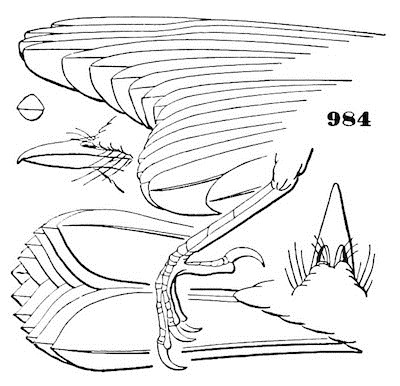
Setophaga ruticilla, Sw.
984
Gen. Char. Bill much depressed, the lateral outlines straight towards tip. Bristles reach half-way from nostril to tip. Culmen almost straight to near the tip; commissure very slightly curved. Nostrils oval, with membrane above them. Wings rather longer than tail, pointed; second, third, and fourth quills nearly equal; first intermediate between fourth and fifth. Tail rather long, rather rounded; the feathers broad, and widening at ends, the outer web narrow. Tarsi with scutellar divisions indistinct externally. Legs slender; toes short, inner cleft nearly to base of first joint, outer with first joint adherent; middle toe without claw, not quite half the tarsus.
The genus Setophaga is very largely represented in America, although of the many species scarcely any agree exactly in form with the type. In the following diagnosis I give several species, referred to, perhaps erroneously, as occurring in Texas.
Belly white. End of lateral tail-feathers black. Sexes dissimilar.
Ground-color black, without vertex spot. Sides of breast and bases of quills and tail-feathers reddish-orange in male, yellowish in female … ruticilla.
Belly vermilion or carmine red. Lateral tail-feathers, including their tips, white. Sexes similar.
Entirely lustrous black, including head and neck. No vertex spot. A white patch on the wings … picta.60
Plumbeous-ash, including head and neck. A chestnut-brown vertex spot. No white on wings … miniata.61
Setophaga ruticilla, SwainsAMERICAN REDSTARTMotacilla ruticilla, Linn. Syst. Nat. 10th ed. 1758, 186 (Catesby, Car. tab. 67). Muscicapa ruticilla, Linn.; Gmelin; Vieillot; Wils.; Bon.; Aud. Orn. Biog. I, pl. xl. Setophaga rut. Swains. Zoöl. Jour. III, 1827, 358.—Bon.; Aud. Birds Am.—Sclater, P. Z. S. (Ecuador, Bogota, Cordova, Oaxaca, City of Mexico).—Sclater & Salvin, Ibis, 1859, 12 (Guatemala).—Baird, Birds N. Am. 1858, 297; Rev. 256.—Max.; Sallé, P. Z. S. 1857 (St. Domingo).—Newton, Ibis, 1859, 143 (St. Croix; winter).—Cab. Jour. 1856, 472 (Cuba); 1860, 325 (Costa Rica).—Gundlach, Ib. 1861, 326 (Cuba).—Bryant, Pr. Bost. Soc. VII, 1859 (Bahamas).—Lawrence, Ann. N. Y. Lyc. 1861, 322 (Panama R. R.).—Samuels, 249. Sylvania rut. Nuttall, Man. I, 1832, 291 (type of genus). Motacilla flavicauda, Gmelin, I, 1788, 997 (♀).
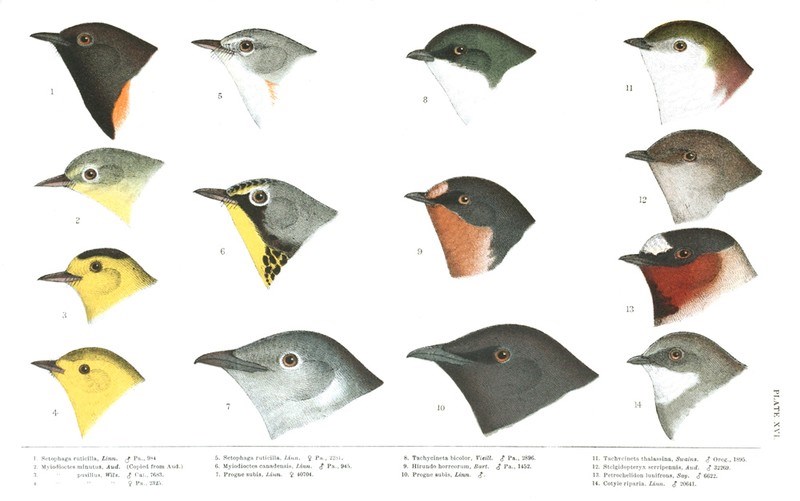
PLATE XVI.
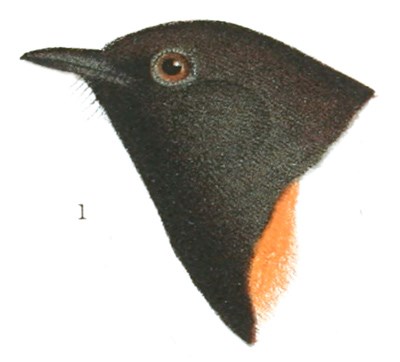
1. Setophaga ruticilla, Linn. ♂ Pa., 984.
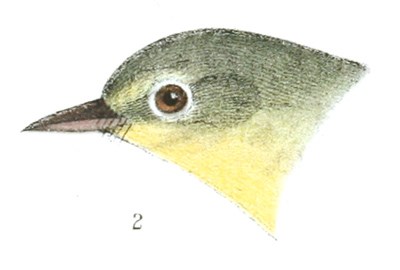
2. Myiodioctes minutus, Aud. (Copied from Aud.)

3. Myiodioctes pusillus, Wils. ♂ Cal., 7683.

4. Myiodioctes pusillus, Wils. ♀ Pa., 2325.
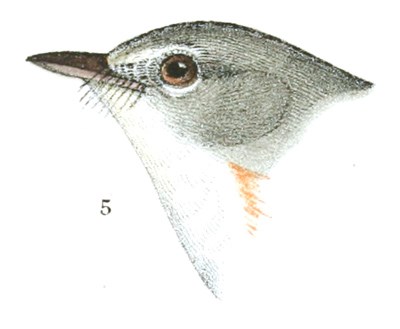
5. Setophaga ruticilla, Linn. ♀ Pa., 2281.

6. Myiodioctes canadensis, Linn. ♂ Pa., 945.

7. Progne subis, Linn. ♀ 40704.
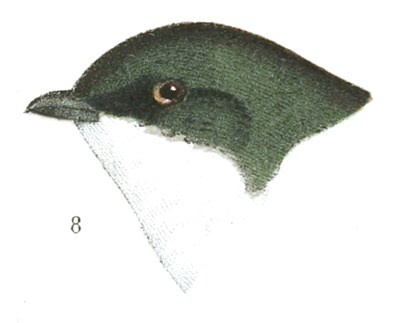
8. Tachycineta bicolor, Vieill. ♂ Pa., 2896.

9. Hirundo horreorum, Bart. ♂ Pa., 1452.

10. Progne subis, Linn. ♂.

11. Tachycineta thalassina, Swains. ♂ Oreg., 1895.

12. Stelgidopteryx serripennis, Aud. ♂ 32269.
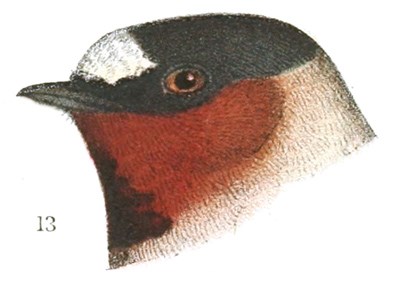
13. Petrochelidon lunifrons, Say. ♂ 6622.

14. Cotyle riparia, Linn. ♂ 20641.
Sp. Char. Male. Prevailing color black. A central line on the breast, the abdomen, and under tail-coverts white; some feathers in the latter strongly tinged with dark brown. Bases of all the quills except the inner and outer, and basal half of all the tail-feathers except the middle one, a patch on each side of the breast, and the axillary region, orange-red, of a vermilion shade on the breast. Female with the black replaced by olive-green above, by brownish-white beneath, the red replaced by yellow; the head tinged with ash; a grayish-white lore and ring round the eye. Length, 5.25; wing, 2.50; tail, 2.45.
Hab. Eastern and in part Middle Provinces of North America to Fort Simpson, west to Great Salt Lake; Fort Laramie; Denver City; most of the West Indies; Mexico to Ecuador.
The young male in early autumn greatly resembles in plumage the adult female, but has the upper tail-coverts and tail deep black, sharply contrasted with the olive of the rump, instead of having the upper tail-coverts olive, the tail simply dusky; in addition the back is more greenish-olive, and the abdomen and crissum pure white. The male does not obtain the perfect adult plumage until about the third year.
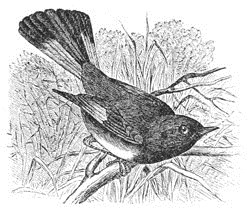
Setophaga ruticilla.
Habits. The so-called Redstart has an extended distribution from the Atlantic to the Rocky Mountains, and from Florida to high northern latitudes, having been found breeding at Fort Simpson by Mr. Ross, and at Fort Resolution by Mr. Kennicott and Mr. Lockhart. It is generally abundant in suitable localities, and probably breeds wherever found north of the Potomac. It winters in large numbers in Guatemala and in other parts of Central America, as well as in the West Indies. It is common in St. Croix in the spring, and is especially seen about houses, according to Newton. It remains there until the end of April.
Richardson found this species abundant on the Saskatchewan, as far to the north as the fifty-eighth parallel. It appeared there the last of May, and left early in September. He found it frequenting moist, shady lands, flitting about among the moss-grown and twisted stems of the tall willows that skirt the marshes. It was easily recognized by the red lining of its wings as it flitted through the gloomy shades in pursuit of mosquitoes and other winged insects.
Among the memoranda of the late Mr. Kennicott, we find two to the effect that on the 26th of May he found both males and females of this species common near Rainy Lake, and that on the 6th of June he also observed these birds near Lake Winnepeg. June 14, at Fort Resolution, he obtained a female Redstart with nest and four eggs. The nest was built in the fork of a willow, in a thick but low wood of alder and willow. It was entirely unprotected by leaves or branches. The female was taken on the nest.
The Newtons found this a very common species in St. Croix, in the spring of the year, and it was especially seen about houses. For about a week, at the end of April, 1857, they were extremely numerous. On their return from their summer quarters, they were first observed September 6. Mr. Taylor also mentions them as common in Trinidad. Mr. Ridgway found it a common species among the willow thickets of the river valleys, west as far as the Great Salt Lake.
This species, in its spring and autumnal migrations, is abundant in Louisiana and Texas, as well as in the Gulf States. Wilson speaks of meeting with it in the then “Mississippi Territory.” Audubon gives it as abundant in Louisiana, and Nuttall as found throughout Louisiana and Arkansas into Mexico. Mr. Dresser also mentions it as very common near San Antonio in the spring and autumn, arriving on the Medina the 27th of April.
Dr. Coues says that the Redstart near Washington is chiefly a spring and autumnal visitant, and but very few remain to breed. In the spring it is very abundant from April 25 to May 20, and in the fall from the 1st to the 20th of September, in all woody and swampy situations. He found it in the habit of running along slender twigs, sideways, and having a note very similar to that of D. œstiva.
Although placed among the Oscines, where, as an excellent singer, it clearly has a good right to be classed, it is yet also a true Flycatcher in habits and manners. It is a lively, active bird, ever on the wing, and continually in pursuit of insects. In this pursuit it never awaits the approach of its prey, but, espying them at a distance, darts with great velocity in pursuit, and the continued clicks of its bill attest the rapidity and frequency with which it will overtake and catch insect after insect. Even when lamenting the loss of a part of its brood, and flying around with cries of distress, the sight of passing insects is a temptation not to be resisted, and the parent bird will stop her lamentations to catch small flies.
Its notes are a varied twitter, rather than a song, a repetition of two simple notes, uttered every few seconds as it seeks its prey, flying among the thick foliage usually in dense groves. Its common habit is to glide along a branch, between its smaller twigs, at times darting forth into more open spaces in quest of insects it has espied.
Their nests are usually, though not always, built in a low branch, eight or ten feet from the ground, in the midst of a thick grove. I have known it to build in an open field and in close proximity to a dwelling. It keeps to groves and thickets, and frequents moist places rather than dry, evidently because of the greater abundance of insects, and not because of timid or retiring habits. It is indeed far from being timid, and will permit a near approach without any exhibitions of uneasiness. When its nest is visited, the male bird manifests great disturbance, and flies back and forth around the head of the intruder with cries of distress. The female is far less demonstrative, and even when her nest is despoiled before her eyes is quite moderate in the expression of her grief.
Its flight is graceful, easy, and rapid, varied by circumstances as it glides in its intricate course among small interlacing branches, or darts rapidly forth into more open space. As it moves, it is continually opening out, closing, or flirting from side to side its conspicuous tail, the white spots in its expanded feathers constantly appearing and disappearing.
In the construction of the nest there is a general uniformity of character, although the materials differ and the localities are far apart. They are never pendent, but are placed among three or more small upright branches, around which it is firmly woven with vegetable flax-like fibres. A nest obtained in Lynn, by Mr. George O. Welch (S. I. 3,778), in June, measures two inches in height by three in diameter. It is a small, compact, and homogeneous nest, composed almost entirely of shreds of savin-bark intermixed with soft vegetable wool. Within are loosely intertwined minute vegetable fibres and strips of bark, and a lining of horsehair, fine pine leaves, and dry grasses. The nest contained four eggs. Another nest found in Grand Menan, June 24, 1851, was very similar in size, structure, and materials. It was in the centre of a thick, swampy thicket, five feet from the ground, and contained five eggs.




